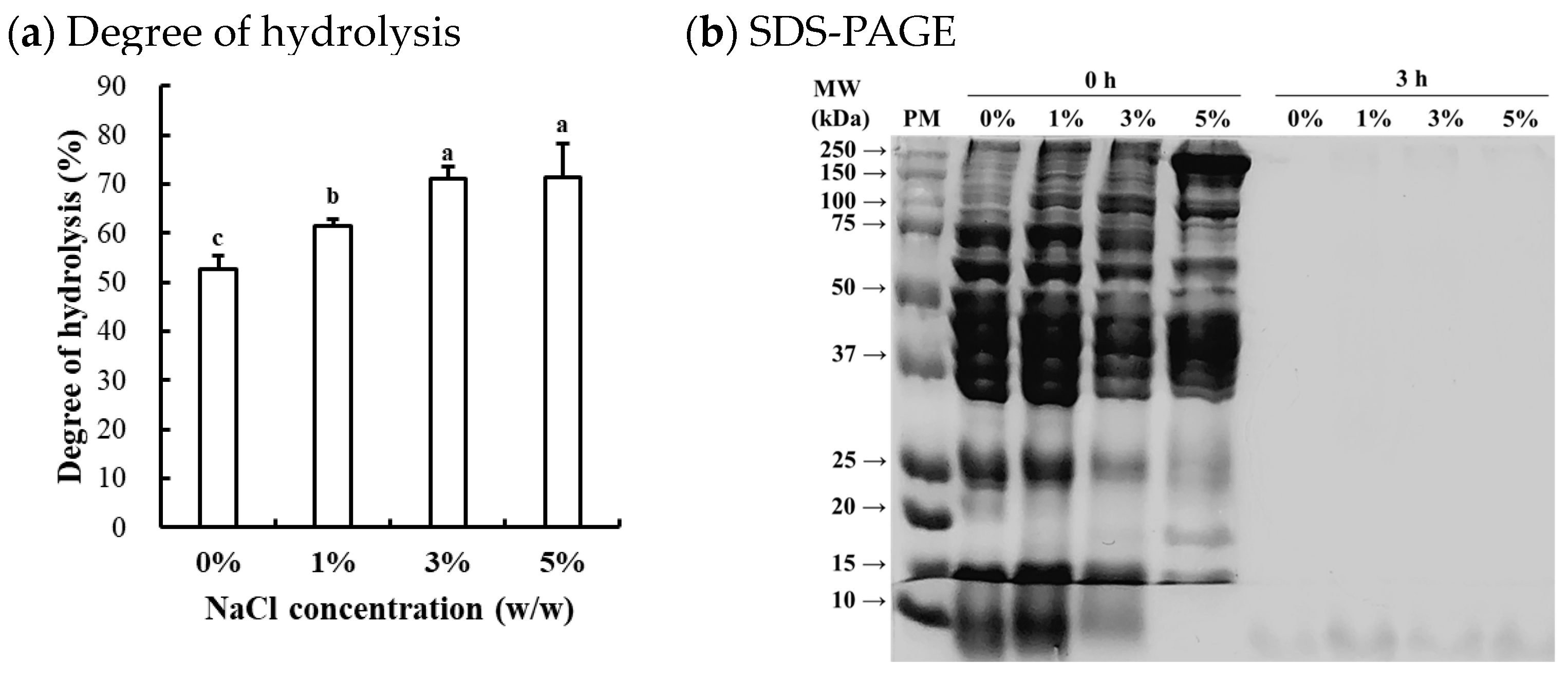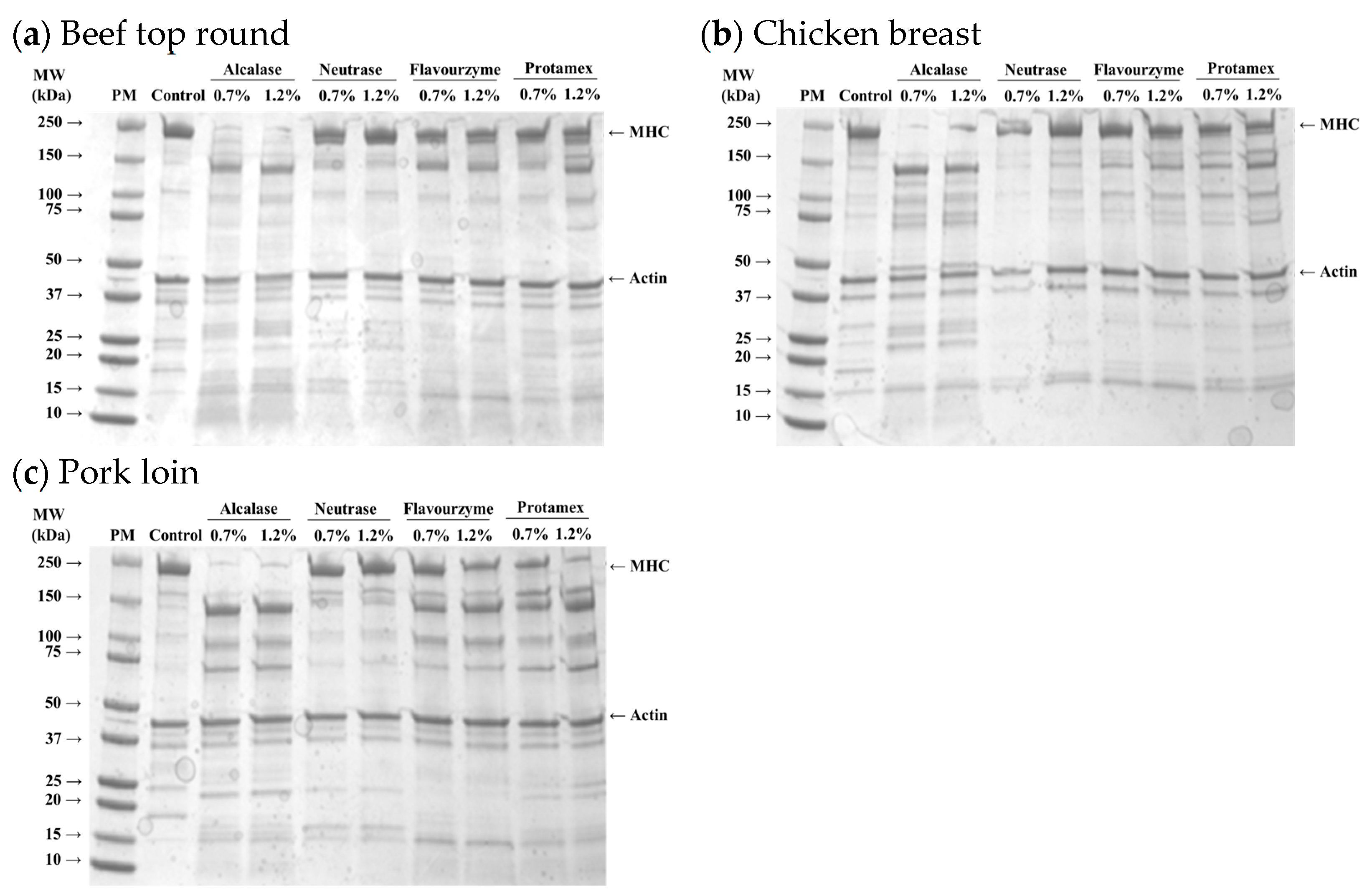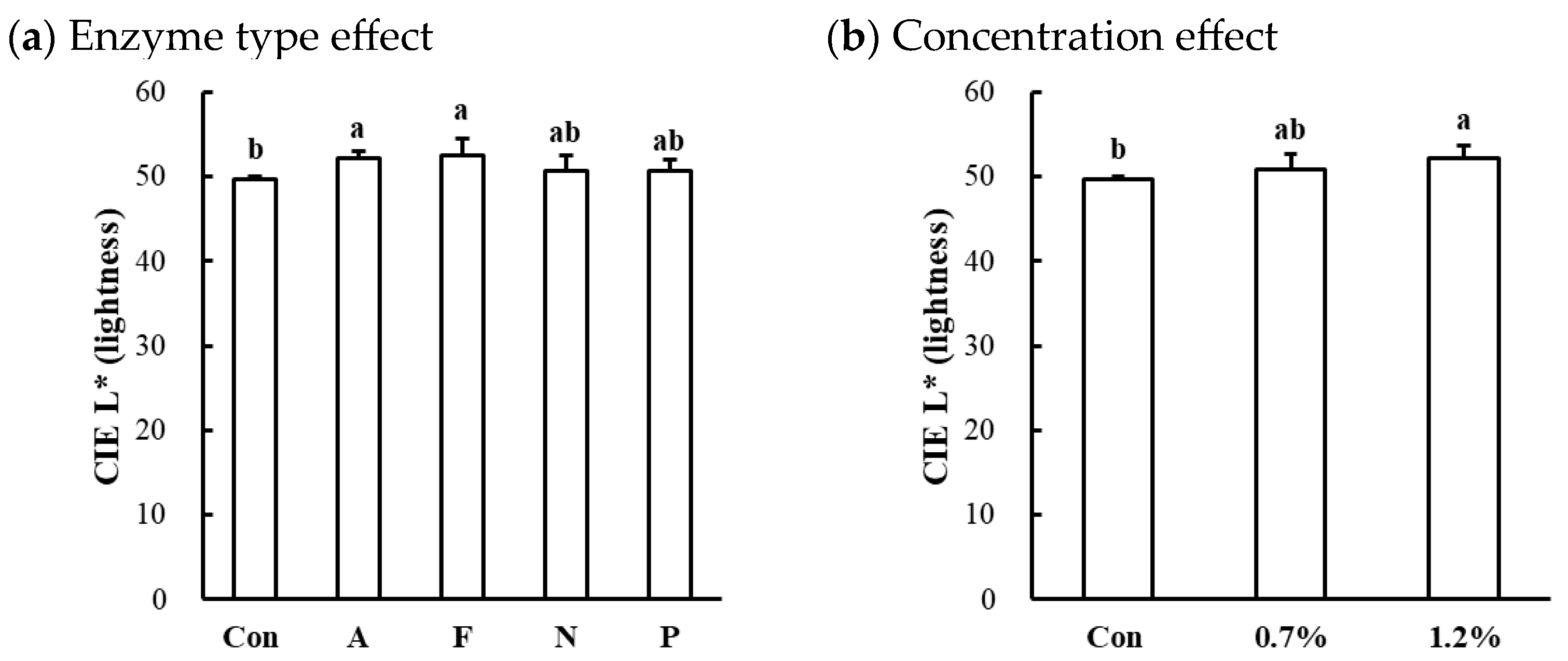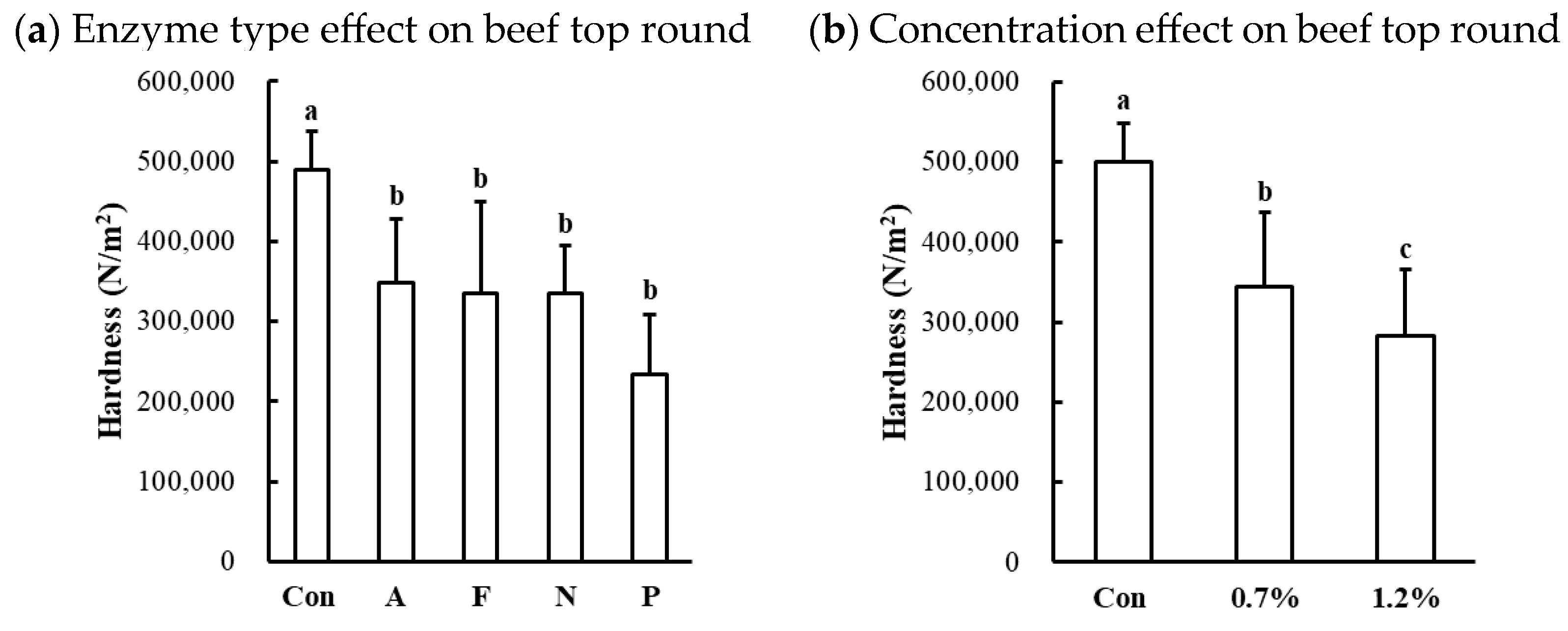Evaluation of the Physicochemical Attributes of Beef, Chicken, and Pork Muscles Injected with Microbial Proteases for Designing Senior-Friendly Processed Meat Products
Abstract
1. Introduction
2. Materials and Methods
2.1. Materials
2.2. Sample Prepration
2.2.1. Hydrolytic Efficacy Under Different NaCl Concentrations (Experiment I)
2.2.2. Physicochemical Properties of Microbial Protease-Injected Muscles (Experiment II)
2.3. Physicochemical Analysis
2.3.1. Degree of Hydrolysis
2.3.2. Sodium Dodecyl Sulfate-Polyacrylamide Gel Electrophoresis (SDS-PAGE)
2.3.3. pH Value
2.3.4. Instrumental Color
2.3.5. Cooking Loss
2.3.6. Hardness Measurement
2.4. Statistical Analysis
3. Results and Discussion
3.1. Hydrolytic Efficacy Under Different NaCl Concentrations (Experiment I)
3.1.1. Degree of Hydrolysis
3.1.2. SDS-PAGE
3.2. Physicochemical Properties of Microbial Protease-Injected Muscles (Experiment II)
3.2.1. Protein Patterns of Myofibrillar Proteins from Microbial Protease-Injected Muscles
3.2.2. Effects of Enzyme Type and Concentration on Microbial Protease-Injected Muscles
3.2.3. pH Value of Microbial Protease-Injected and Cooked Muscles
3.2.4. Color Characteristic of Microbial Protease-Injected and Cooked Muscles
3.2.5. Cooking Loss of Microbial Protease-Injected and Cooked Muscles
3.2.6. Hardness of Microbial Protease-Injected and Cooked Muscles
4. Conclusions
Author Contributions
Funding
Institutional Review Board Statement
Informed Consent Statement
Data Availability Statement
Acknowledgments
Conflicts of Interest
References
- Spence, C.; Youssef, J. Aging and the (chemical) senses: Implications for food behaviour amongst elderly consumers. Foods 2021, 10, 168. [Google Scholar] [CrossRef] [PubMed]
- Kang, M.; Jung, H.W. Association between oral health and frailty in older Korean population: A cross-sectional study. Clin. Interv. Aging 2022, 17, 1863–1872. [Google Scholar] [CrossRef] [PubMed]
- Korean Agency for Technology and Standards. Korean Industrial Standards Seniors Friendly Foods (KS H 4897). Korean Agency for Technology and Standards. 2022. Cited 2024 September. Available online: https://standard.go.kr/KSCI/portalindex.do (accessed on 16 September 2024).
- Park, H.; Um, K.H.; Lee, S. A hardness survey on crushed meat products in the Korean market for the development of meat foods for seniors. Food Eng. Prog. 2019, 23, 139–145. [Google Scholar] [CrossRef]
- Kim, H.W.; Choi, Y.S.; Choi, J.H.; Kim, H.Y.; Lee, M.A.; Hwang, K.E.; Song, D.H.; Lim, Y.B.; Kim, C.J. Tenderization effect of soy sauce on beef M. biceps femoris. Food Chem. 2013, 139, 597–603. [Google Scholar] [CrossRef] [PubMed]
- Gagaoua, M.; Terlouw, E.M.C.; Mullen, A.M.; Franco, D.; Warner, R.D.; Lorenzo, J.M.; Purslow, P.P.; Gerrad, D.; Hopkins, D.; Troy, D.; et al. Molecular signatures of beef tenderness: Underlying mechanisms based on integromics of protein biomarkers from multi-platform proteomics studies. Meat Sci. 2021, 172, 108311. [Google Scholar] [CrossRef]
- Warner, R.D.; Wheeler, T.L.; Ha, M.; Li, X.; Bekhit, A.E.-D.; Morton, J.; Vaskoska, R.; Dunshea, F.R.; Liu, R.; Purslow, P.; et al. Meat tenderness: Advances in biology, biochemistry, molecular mechanisms and new technologies. Meat Sci. 2022, 185, 108657. [Google Scholar] [CrossRef]
- Kim, H.W.; Kim, Y.H.B. Effects of aging and freezing/thawing sequence on quality attributes of bovine Mm. gluteus medius and Biceps femoris. Asian-Australas J. Anim. Sci. 2017, 30, 254–261. [Google Scholar] [CrossRef]
- Dang, D.S.; Buhler, J.F.; Davis, H.T.; Thornton, K.J.; Scheffler, T.L.; Matarneh, S.K. Inhibition of mitochondrial calcium uniporter enhances postmortem proteolysis and tenderness in beef cattle. Meat Sci. 2020, 162, 108039. [Google Scholar] [CrossRef]
- Azmi, S.I.M.; Kumar, P.; Sharma, N.; Sazili, A.Q.; Lee, S.J.; Ismail-Fitry, M.R. Application of plant proteases in meat tenderization: Recent trends and future prospects. Foods 2023, 12, 1336. [Google Scholar] [CrossRef]
- Tavano, O.L.; Berenguer-Murcia, A.; Secundo, F.; Fernandez-Lafuente, R. Biotechnological applications of proteases in food technology. Compr. Rev. Food Sci. Food Saf. 2018, 17, 412–436. [Google Scholar] [CrossRef]
- Jung, S.H.; Song, K.B. Isolation of calcium-binding peptides from porcine meat and bone meal and mussel protein hydrolysates. Korean J. Food Preserv. 2015, 22, 297–302. [Google Scholar] [CrossRef]
- Laemmli, U.K. Cleavage of structural protein during the assembly of the head of bacteriophage T4. Nature 1970, 227, 680–685. [Google Scholar] [CrossRef] [PubMed]
- Song, D.H.; Gu, T.W.; Kim, H.W. Quality characteristics of senior-friendly gelatin gels formulated with hot water extract from red maple leaf as a novel anthocyanin source. Foods 2021, 10, 3074. [Google Scholar] [CrossRef] [PubMed]
- Mora, L.; Toldrá, F. Advanced enzymatic hydrolysis of food proteins for the production of bioactive peptides. Curr. Opin. Food Sci. 2023, 49, 100973. [Google Scholar] [CrossRef]
- Chen, X.; Tume, R.K.; Xu, X.; Zhou, G. Solubilization of myofibrillar proteins in water or low ionic strength media: Classical techniques, basic principles, and novel functionalities. Crit. Rev. Food Sci. Nutr. 2017, 57, 3260–3280. [Google Scholar] [CrossRef]
- Butré, C.I.; Wierenga, P.A.; Gruppen, H. Effects of ionic strength on the enzymatic hydrolysis of diluted and concentrated whey protein isolate. J. Agric. Food Chem. 2012, 60, 5644–5651. [Google Scholar] [CrossRef]
- Zago, I.C.C.; Mendonça, F.J.; Belluco, C.Z.; Menck, A.L.G.; Soares, A.L. Preparation of a cooked and slated chicken breast product using Alcalase-hydrolyzed wooden breast fillets. Food Sci. Technol. 2023, 43, e97422. [Google Scholar] [CrossRef]
- Xing, T.; Zhao, X.; Han, M.; Cai, L.; Deng, S.; Zhou, G.; Xu, X. A comparative study of functional properties of normal and wooden breast broiler chicken meat with NaCl addition. Poult. Sci. 2017, 96, 3473–3481. [Google Scholar] [CrossRef]
- Ertbjerg, P.; Puolanne, E. Muscle structure, sarcomere length and influences on meat quality: A review. Meat Sci. 2017, 132, 139–152. [Google Scholar] [CrossRef]
- Xu, Y.; Xu, X. Modification of myofibrillar protein functional properties prepared by various strategies: A comprehensive review. Compr. Rev. Food Sci. Food Saf. 2021, 20, 458–500. [Google Scholar] [CrossRef]
- Abdel-Naeem, H.H.S.; Mohamed, H.M.H. Improving the physico-chemical and sensory characteristics of camel meat burger patties using ginger extract and papain. Meat Sci. 2016, 118, 52–60. [Google Scholar] [CrossRef] [PubMed]
- Ribeiro, W.O.; Ozaki, M.M.; dos Santos, M.; Rodríguez, A.P.; Pflanzer, S.B.; Pollonio, M.A.R. Interaction between papain and transglutaminase enzymes on the textural softening of burgers. Meat Sci. 2021, 174, 108421. [Google Scholar] [CrossRef] [PubMed]
- Morzel, M.; Gatellier, P.; Sayd, T.; Renerre, M.; Laville, E. Chemical oxidation decreases proteolytic susceptibility of skeletal muscle myofibrillar proteins. Meat Sci. 2006, 73, 536–543. [Google Scholar] [CrossRef] [PubMed]
- Von Seggern, D.D.; Calkins, C.R.; Johnson, D.D.; Brickler, J.E.; Gwartney, B.L. Muscle profiling: Characterizing the muscles of the beef chuck and round. Meat Sci. 2005, 71, 39–51. [Google Scholar] [CrossRef] [PubMed]
- Zhang, T.; Chen, C.; Xie, K.; Wang, J.; Pan, Z. Current state of metabolomics research in meat quality analysis and authentication. Foods 2021, 10, 2388. [Google Scholar] [CrossRef]
- Puolanne, E.; Kivikari, R. Determination of the buffering capacity of postrigor meat. Meat Sci. 2000, 56, 7–13. [Google Scholar] [CrossRef]
- Huff-Lonergan, E.; Lonergan, S.M. Mechanisms of water-holding capacity of meat: The role of postmortem biochemical and structural changes. Meat Sci. 2005, 71, 194–204. [Google Scholar] [CrossRef]
- Mancini, R.A.; Hunt, M.C. Current research in meat color. Meat Sci. 2005, 71, 100–121. [Google Scholar] [CrossRef]
- Liu, H.; Li, Q.; Zhao, D.; Zhang, M.; Jiang, S.; Li, C. Changes in the structure and digestibility of myoglobin treated with sodium chloride. Food Chem. 2021, 363, 130284. [Google Scholar] [CrossRef]
- Singh, A.; Benjakul, S. Proteolysis and its control using protease inhibitors in fish and fish products: A review. Compr. Rev. Food Sci. Food Saf. 2018, 17, 496–509. [Google Scholar] [CrossRef]
- Puolanne, E.; Halonen, M. Theoretical aspects of water-holding in meat. Meat Sci. 2010, 86, 151–165. [Google Scholar] [CrossRef] [PubMed]
- Jun-hui, X.; Hui-juan, C.; Bin, Z.; Hui, Y. The mechanistic effect of bromelain and papain on tenderization in jumbo squid (Dosidicus gigas) muscle. Food Res. Int. 2020, 131, 108991. [Google Scholar] [CrossRef] [PubMed]
- Arroyo, C.; Kennedy, T.M.; Lyng, J.G.; O’Sullivan, M. Comparison of conventional heat treatment with selected non-thermal technologies for the inactivation of the commercial protease Protamex™. Food Bioprod. Process. 2017, 105, 95–103. [Google Scholar] [CrossRef]







| Muscle Type | Effect | pH | Color Characteristic | Cooking Loss | Shear Force | ||
|---|---|---|---|---|---|---|---|
| CIE L* | CIE a* | CIE b* | |||||
| Beef top round | Enzyme type (E) | <0.001 | 0.029 | NS | NS | NS | 0.008 |
| Concentration (C) | <0.001 | 0.024 | NS | NS | 0.002 | 0.009 | |
| Interaction (E × C) | NS 1 | NS | NS | NS | 0.008 | NS | |
| Chicken breast | Enzyme type (E) | NS | NS | NS | NS | <0.001 | 0.001 |
| Concentration (C) | NS | NS | NS | NS | 0.013 | NS | |
| Interaction (E × C) | NS | NS | NS | NS | 0.049 | NS | |
| Pork loin | Enzyme type (E) | NS | NS | NS | NS | NS | 0.001 |
| Concentration (C) | NS | NS | NS | NS | NS | NS | |
| Interaction (E × C) | NS | NS | NS | NS | NS | NS | |
| Treatment | Beef Top Round | Chicken Breast | Pork Loin |
|---|---|---|---|
| Untreated control | 6.07 ± 0.03 | 6.52 ± 0.07 | 6.10 ± 0.02 |
| Microbial protease-injected | 5.95 ± 0.08 | 6.47 ± 0.06 | 6.03 ± 0.29 |
| Significance of p value | <0.001 | NS 1 | NS |
| Trait | Treatment | Beef Top Round | Chicken Breast | Pork Loin |
|---|---|---|---|---|
| CIE L* (lightness) | Untreated control | 49.66 ± 0.42 | 77.76 ± 2.78 | 73.36 ± 1.50 |
| Microbial protease-injected | 51.52 ± 1.71 | 79.09 ± 2.61 | 73.27 ± 1.84 | |
| Significance of p value | <0.001 | NS 1 | NS | |
| CIE a* (redness) | Untreated control | 4.01 ± 0.76 | −0.59 ± 1.29 | −2.71 ± 1.15 |
| Microbial protease-injected | 3.82 ± 0.60 | −0.99 ± 0.71 | −1.62 ± 0.96 | |
| Significance of p value | NS | NS | NS | |
| CIE b* (yellowness) | Untreated control | 14.54 ± 0.37 | 14.63 ± 0.64 | 14.26 ± 0.56 |
| Microbial protease-injected | 14.32 ± 0.51 | 15.41 ± 0.91 | 14.58 ± 0.79 | |
| Significance of p value | NS | NS | NS |
Disclaimer/Publisher’s Note: The statements, opinions and data contained in all publications are solely those of the individual author(s) and contributor(s) and not of MDPI and/or the editor(s). MDPI and/or the editor(s) disclaim responsibility for any injury to people or property resulting from any ideas, methods, instructions or products referred to in the content. |
© 2024 by the authors. Licensee MDPI, Basel, Switzerland. This article is an open access article distributed under the terms and conditions of the Creative Commons Attribution (CC BY) license (https://creativecommons.org/licenses/by/4.0/).
Share and Cite
Kim, S.-Y.; Song, D.-H.; Chung, W.; Choi, H.-S.; Han, S.G.; Kim, H.-W. Evaluation of the Physicochemical Attributes of Beef, Chicken, and Pork Muscles Injected with Microbial Proteases for Designing Senior-Friendly Processed Meat Products. Foods 2024, 13, 3430. https://doi.org/10.3390/foods13213430
Kim S-Y, Song D-H, Chung W, Choi H-S, Han SG, Kim H-W. Evaluation of the Physicochemical Attributes of Beef, Chicken, and Pork Muscles Injected with Microbial Proteases for Designing Senior-Friendly Processed Meat Products. Foods. 2024; 13(21):3430. https://doi.org/10.3390/foods13213430
Chicago/Turabian StyleKim, Si-Young, Dong-Heon Song, Wookyung Chung, Hyun-Shik Choi, Sung Gu Han, and Hyun-Wook Kim. 2024. "Evaluation of the Physicochemical Attributes of Beef, Chicken, and Pork Muscles Injected with Microbial Proteases for Designing Senior-Friendly Processed Meat Products" Foods 13, no. 21: 3430. https://doi.org/10.3390/foods13213430
APA StyleKim, S.-Y., Song, D.-H., Chung, W., Choi, H.-S., Han, S. G., & Kim, H.-W. (2024). Evaluation of the Physicochemical Attributes of Beef, Chicken, and Pork Muscles Injected with Microbial Proteases for Designing Senior-Friendly Processed Meat Products. Foods, 13(21), 3430. https://doi.org/10.3390/foods13213430







